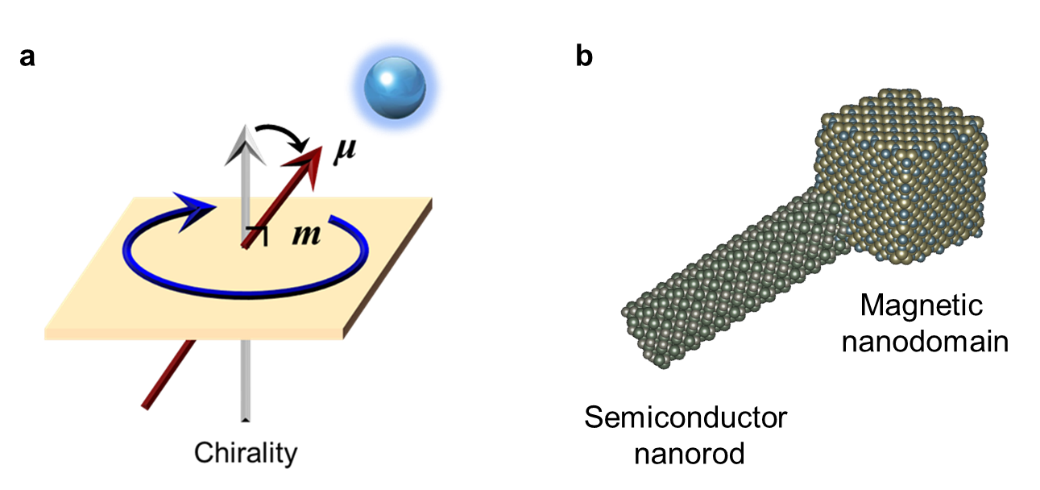The USTC team of Chinese Academy of Science (CAS) led by Prof. YU Shuhong (USTC), collaborating with Prof. TANG Zhiyong (National Center for Nanoscience and Technology, China) and Prof. Edward H. Sargent (University of Toronto), has shed new lights on the topic of chiral inorganic nanomaterials. Researchers demonstrated a regioselective magnetization strategy, achieving a library of semiconducting heteronanorods with chiroptical activities. The research article entitled “Regioselective magnetization in semiconducting nanorods” was published in Nature Nanotechnology (Nat. Nanotechnol. 2020, 10.1038/s41565-019-0606-8) on Jan 20th.
Chirality – the property of an object non-superimposable with its mirror image – is of widespread interest in physics, chemistry, and biology. Traditional chemical construction of chiral nanomaterials by the introduction of chiral structures has its limitation due to such materials’ environmental instability and poor conductivity.

a. Schematic illustration of magnetically induced chiroptical activity.
b, Model of materialized magnetite nanodomain at one apex of ZnxCd1-xS semiconductor nanorod.
Designing magneto-optical nanomaterials offers an opportunity to modulate the interactions between electric and magnetic dipoles via the local magnetic field, underlining another promising approach to enable chirality (Figure a). To materialize such chiroptically active media, the growth of magnetic units (i.e. Fe3O4) has to be achieved at targeted locations of parent nanomaterials. One-dimensional chalcogenide semiconductor nanorods stand out to serve as the parent materials due to their compelling qualities, however, technical challenges lie in the epitaxial growth between host and motif materials of large lattice and chemical mismatches, let alone the regioselective growth.
Taking up the challenge, researchers reported a double-buffer-layer engineering strategy, which is able to tune the surface activity and interfacial energy locally, to achieve the selective growth of magnetic materials at specific locations on a wide variety of semiconducting nanorods (i.e. ZnxCd1-xS, where 0≤x≤1, as is shown in Figure b). The researchers sequentially integrated Ag2S and Au intermediate layers at one apex of each nanorod to catalyze the site-specific growth of Fe3O4 nanodomains, leading to the high-yielding one-dimensional ZnxCd1-xS-Ag2S/Au@Fe3O4 quaternary heteronanorods, whose structure has been validated through power X-ray diffraction patterns. The researcher further examined the structure and formation mechanism of the products and investigated their electron dynamics. The obtained nanomaterials exhibit high optical activity and furthermore, the absorption of these nanorods across the ultraviolet and visible regime can be controlled by the Zn/Cd ratio, where 0.9:0.1 was proved to be better according to the experiments.
The phenomena is demonstrated that, due to the location-specific magnetic field introduced by the site-specific Fe3O4 nanoparticle, the resulting magnetized heteronanorods exhibit deflected electric dipole moment. In this way, the angle deflection between electric and magnetic transition dipoles induces chiroptical activity in the absence of chiral ligands, helical structures, and chiral lattices – a phenomenon not observed outside of modulation.
Researchers’ other experiments suggested that the method can be applied to other semiconductor system as well. The regioselective magnetization strategy opens a new avenue to designing optically active nanomaterials for chirality and spintronics.
This work was supported by the National Natural Science Foundation of China, the Foundation for Innovative Research Groups of the National Natural Science Foundation of China, and Key Research Program of Frontier Sciences, CAS (Grant QYZDJ-SSW-SLH036).
Paperlink:
https://www.nature.com/articles/s41565-019-0606-8
(Edited by LI Xiaoxi, JIANG Pengcen, USTC News Center)